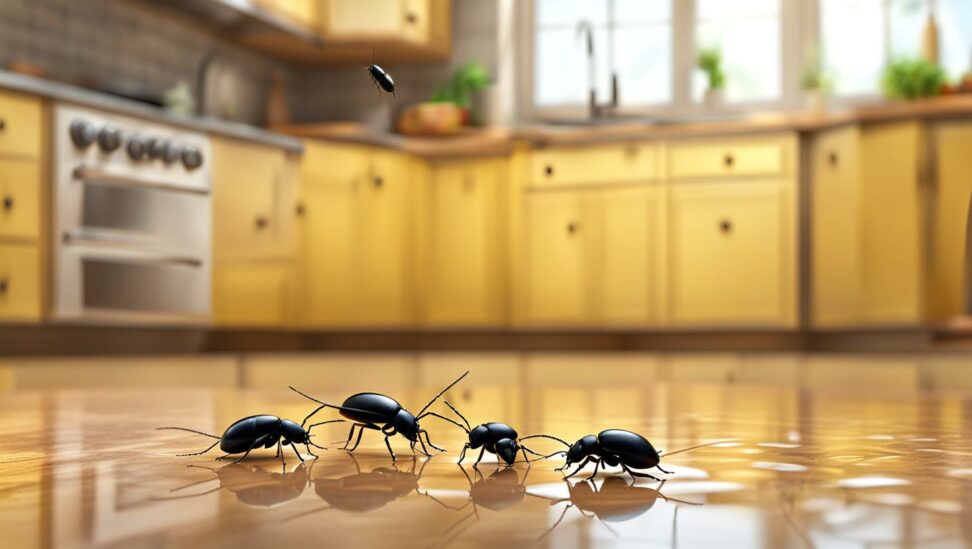Kitchen Crawling with Tiny Black Bugs? Fix It Fast!
Finding an army of tiny black bugs roaming your kitchen is disconcerting and frustrating. You open a cabinet expecting to grab a box of pasta, and instead find insects scattering away from the light. Or you notice dark spots peppering your countertops and crawling along the corners. Where did these unwelcome pests come from and how do you banish them for good?
Pinpointing the Culprits
The first step is figuring out exactly what type of tiny black bugs has infested your kitchen. While there are many possibilities, some of the usual suspects include:

Cockroaches
Cockroaches are one of the most frequent kitchen pests. They are flat brown or black insects with long antennae and are adept at squeezing into the smallest crevices. Roaches contaminate surfaces with their droppings that can trigger allergies and asthma. An extensive roach takeover is evident from bug sightings, oily streaks along walls, and a musty odor.
Ants
Another common kitchen invader is ants. Tiny black ants enter through cracks and gaps in search of sugary or greasy food. They follow scent trails to food sources and can appear in large numbers if they find a prime target. Signs of ants include small piles of sand-like granules and clusters of ants gathering in corners or around pipes.
Pantry Pests
Varieties of pantry pests or stored product insects can show up in kitchens feeding on dried goods. These include grain and flour beetles, meal moths, and weevils. Look for clumps of insects near food containers, larvae in packages, and white silky webbing from moths.
Identifying the specific bug is key to targeting removal methods. For severe infestations, an exterminator can pinpoint the exact species to ensure eradication.
Exterminating an Infestation
Once you know what you are dealing with, it’s time to evict the bugs. An integrated pest management approach works best combining prevention, natural deterrents, traps and targeted chemicals if needed.
Sealing Entry Points
Insects access kitchens through astonishingly small openings. Sealing any cracks around pipes, vents, windows and doors prevents access. Holes in walls or floors also provide entry and should be sealed. Take preventative measures like weather stripping and screening to fortify your home’s exterior.
Kitchen Sanitation
Bugs feast on tiny crumbs and spills humans barely notice. Implement diligent daily cleaning regimens in infested areas. Store food in airtight containers rather than cardboard or bags. Eliminate clutter where pests hide and breed. Fix leaks and dry out moist areas. Better sanitation removes food sources bugs need for survival.
Traps and Baits
Strategically place insect monitors or pheromone traps in out-of-sight areas like under appliances to catch bugs. Baits with boric acid or food attractants lure roaches to their demise. DIY traps like jars with bread soaked in sugar water tempt ants. Follow all label instructions carefully when utilizing commercial traps or baits.
Natural Deterrents
Several natural solutions repel insects seeking food and shelter in kitchens. Diatomaceous earth sprinkled in cupboards and cracks destroys exoskeletons. Essential oils like peppermint, tea tree and cinnamon repel many bugs. Vinegar and baking soda cleans away pheromone trails. Take preventative measures like washing countertops and floors with vinegar water.
Chemical Treatments
For heavy infestations, exterminators employ strong chemicals like growth regulators and insecticidal dusts. Use extreme caution with over-the-counter sprays, as they can be toxic for people and pets. Avoid spraying cabinets near food prep areas. Professional help is best for severe bug issues.
Getting rid of the bugs is only half the battle, as they inevitably try to return. Maintain vigilance, keep kitchens clean, refresh traps and deterrents. Any new bug spotted should be dealt with immediately to prevent recurring infestations. With persistence and repeated sweeping attacks, your kitchen can finally be free of the swarms of tiny black bugs.
Dealing with small black bugs in the kitchen requires diligence and consistent prevention. But armed with the right information, you can eliminate current and future invasions and enjoy pest-free meal preparation again.